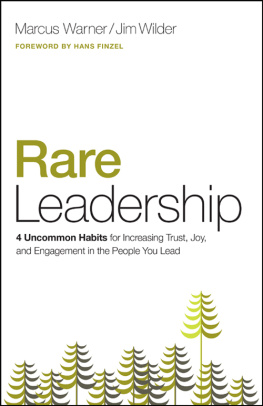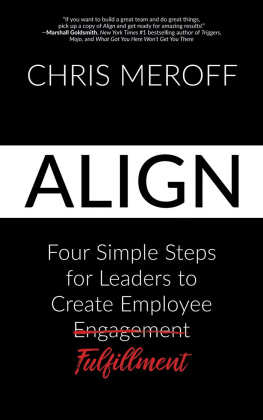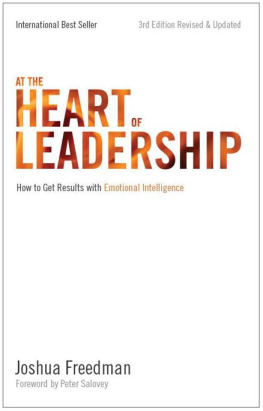Copyright 2008 Annie McKee, Richard Boyatzis, and Frances Johnston
All rights reserved
No part of this publication may be reproduced, stored in or introduced into a retrieval system, or transmitted, in any form,or by any means (electronic, mechanical, photocopying, recording, or otherwise), without the prior permission of the publisher.Requests for permission should be directed to , or mailed to Permissions, Harvard Business SchoolPublishing, 60 Harvard Way, Boston, Massachusetts 02163.
First eBook Edition: February 2008
ISBN: 978-1-4221-1734-7
We dedicate this book to
our childrenshopes and dreams.
Rebecca Renio
Sean Renio
Sarah Renio
Andrew Murphy
Mark Scott
Lucas Johnston-Peck
Miguelangel Johnston-Peck
We have been studying leadership for many years and are often asked why we think it is so important. To us, there is no noblergoal than to lead people to excellence, fulfillment, and collective achievement. Our lives, our society, and our planet havechanged rapidly and unpredictably in recent yearsand this is probably just the tip of the iceberg. If we are to find ourway to a better world, a more stable environment, and societies in which all people have access to lifes gifts, we need peoplewho can see beyond today, spark hope instead of despair, and draw others into an intentional journey of transformation. Weneed more great leaders who think and act in new wayswomen and men unafraid to travel the road less taken, the road thatrequires vision and courage.
The capacity to mobilize energy toward improving the quality of peoples lives is one of the most fascinating and crucialabilities to understandand, ultimately, to master. Throughout our research, practice, and writing, weve sought to answerthese questions: What is great leadership? What differentiates the best leaders from the average? How can people improve theircapacity for resonant leadership, and how can they sustain effectiveness in the face of the daunting responsibilities andinevitable challenges of their roles?
In 2002 we wrote Primal Leadership with Daniel Goleman to begin to answer these questions. We shared research, stories, and our own experiences to build thecase that emotional intelligence and the ability to create resonant relationships were the keys to great leadership. But onequestion persisted: why do so many good leaders fail to reach their potential?
In Resonant Leadership, we again shared research and stories that show how even the best leaders can find it difficult to sustain effectiveness overtime. This is, ironically, particularly true for good leaderspeople who take their roles and responsibilities seriously.In that book, we explained why people often lose their capacity for resonancethey get caught in the Sacrifice Syndrome. Wealso showed how leaders can avoid this syndrome when they adopt practices that spark renewal: mindfulness, hope, and compassion.By tapping into mindfulness and cultivating the capacity for hope and compassion, leaders manage the cycle of sacrifice andrenewal while sustaining resonance and effectiveness over time.
As the messages of these books have spread, we have been asked by people around the world, How can I create resonant relationships? How can I develop emotional intelligence and resonant leadership? How can I renew myself and return to resonance?
We have written this book to answer these questions. We have summarized our key ideas, as well as the research, and includedstories of leaders who have managed to develop and sustain resonance. We have also taken a deliberate departure from our previousbooks approaches. This book includes the most powerful and transformative exercises that we have used with leaders acrossthe globe in all types of organizations. These exercises will help you develop emotional intelligence and your capacity forresonant leadership as you chart a path toward your personal vision for your life and work. We encourage you to really use this bookas you would a workbook. In other words, write in it as you move through the chapters and as you work toward the goal of creating and sustaining resonant leadershipwhether youwish to renew this quality in yourself or to inspire it in others around you.
The Best Way to Use This Book
This book is a tool for personal and professional growth. We want our concepts and exercises to be useful to you. And, becausethis book is probably quite different from other leadership and self-development books you may have read, we would like toprepare you to work most effectively with the ideas and exercises.
Below are a few tips that we have developed from years of experience with the ideas, research, and exercises. Following thelist of tips for using the book is a detailed outline that shows you what lies ahead.
Tips for Getting the Most from This Book
Do the exercises . It is the only way to apply the concepts in the book.
Take time to reflect . The exercises are best done one, two, or, at most, three in one sitting. Do a few, and then come back to the concepts andnext exercises laterthis pace will give you some time to digest what youve learned so that each sitting allows you to buildon the previous ones. Going too quickly through the exercises often results in missing some of the most useful and transformativeexperiences for leaders.
Think and feel as you go . Progress requires reflectionthis means thinking and noticing your feelings about the concepts and insights you developfrom the exercises.
Consider working with a partner . Often, people find that talking with trusted others helps them extract more insight from the thoughts and feelings evokedby the exercises.
Dont be in a rush . It took you years (or decades) to get to this point. You will not find a desired path to the future in a few minutes oreven a few hours. Give yourself the gift of time.
Realize that people are different . At times we offer exercises that might overlap in helping you craft your vision for a desired future and your plan to getthere. We do not know which exercise will work best for you. So if you have achieved tremendous insight from a few exercises,and are reading another that seems similar, you may spend a little less time on it. But remember, each exercise has a distinctpurpose and is tied carefully to those that come before and after. It is best to try to do them all, and in order.
Pay attention to how, when, and where you use this book . If you are like most busy professionals, you will probably try to fit this book into your time on planes, at the end ofthe day, and so forth. We suggest that you also give yourself the gift of dedicated time when you are refreshed and sharp.Sit in a comfortable, inspiring place if you can. Treat the reading of this book and your completion of the exercises as importantworkwork that requires concentration and inspiration.
The Journey to Resonant Leadership
As we have just suggested, your path to resonant leadership can be smoother if you follow the sequential route reflected inthe order of the chapters. After setting up our main ideas and our approach to leadership and learning in by reflecting on what, exactly, it takes to be a resonant leader. A few exercises will help you consider who depends on you for guidance and inspiration, and how you lead people. We will also share exercises, stories, and our research about what great leaders think, feel, and do. You will learnsome common myths about leadership, the importance of emotional and social intelligence, and how good leaders manage the pressureand inevitable sacrifices of their roles through mindfulness, hope, compassion, and renewal.






